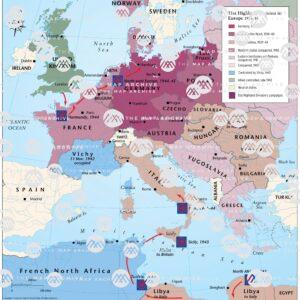Introduction
The Napoleonic Wars, spanning from 1803 to 1815, were a series of conflicts that reshaped the political landscape of Europe and left an indelible mark on history. At the heart of these transformative events were the military campaigns led by Napoleon Bonaparte, whose ambitions for territorial expansion and strategic genius played out across the continent. To truly grasp the complexity and scale of these wars, one must turn to the maps that documented the ebb and flow of battles, alliances, and conquests. In this article, we embark on a cartographic journey through the Napoleonic Wars, exploring the maps that illuminate this pivotal period in European history.
The Rise of Napoleon: 1803-1807
As the Napoleonic Wars unfolded, Napoleon's military prowess became evident, and his conquests reshaped the political map of Europe. Early maps from this period showcase Napoleon's expansionist ambitions, with France at the center of a growing empire. The Italian and German states fell under French control, and the map evolved to reflect the changing alliances and puppet states that characterized this era. The Treaty of Tilsit in 1807, which solidified the alliance between France and Russia, is a key moment in this phase of the conflict. Maps from this time reveal the shifting borders and the emergence of the French Empire as a dominant force in Europe.
Peninsular War: 1808-1814
One of the most intriguing aspects of the Napoleonic Wars is the Peninsular War, where the conflict spilled beyond the borders of continental Europe and into the Iberian Peninsula. Maps from this period illustrate the struggle between French forces and the combined British, Spanish, and Portuguese armies. The rugged terrain and the guerrilla warfare tactics employed by the Spanish resistance are vividly captured in these maps. Iconic battles, such as the Battle of Waterloo, come to life as we trace the movements of armies across the Spanish countryside. The Peninsular War maps tell a story of resilience, determination, and the high cost of imperial ambitions on the Iberian Peninsula.
The Russian Campaign: 1812
Napoleon's ill-fated invasion of Russia in 1812 is a defining chapter in the Napoleonic Wars. Maps detailing the march to Moscow and the disastrous retreat reveal the immense scale of the campaign and the challenges faced by the Grande Armée. The harsh Russian winter and the vastness of the landscape are starkly portrayed on these maps, underlining the logistical nightmare that ultimately led to the downfall of Napoleon's forces. As we follow the path of the retreating army on the map, the devastating toll of the Russian Campaign becomes palpable, marking a turning point in the fortunes of the French Empire.
The Congress of Vienna and the Final Act: 1814-1815
As the Napoleonic Wars map entered their final phase, the Congress of Vienna convened in 1814 to redraw the map of Europe and establish a new balance of power. Maps from this diplomatic gathering showcase the intricate negotiations and the reshaping of borders to restore stability to the continent. The Congress sought to curb the influence of France and prevent the resurgence of a single dominant power, and the resulting maps reflect a delicate equilibrium that aimed to prevent further conflict. However, the Hundred Days, a brief return to power by Napoleon in 1815, disrupted these plans and set the stage for the Battle of Waterloo.
The Battle of Waterloo and the End of an Era
The Battle of Waterloo, fought on June 18, 1815, marked the final chapter of the Napoleonic Wars. Maps of the battlefield provide a detailed account of the troop movements, strategic positions, and the ebb and flow of the conflict. As we examine the maps, we witness the clash of European powers, with the Duke of Wellington leading British and allied forces against Napoleon's army. The iconic moments, such as the charge of the Imperial Guard, are etched onto the maps, immortalizing the decisive moments that brought an end to the Napoleonic era.
Legacy and Impact
The maps of the Napoleonic Wars not only chronicle the geopolitical changes of the time but also provide insights into the evolution of military strategy, the impact of geography on warfare, and the consequences of political decisions. The legacy of these wars is imprinted on the maps, illustrating how the events of 1803-1815 shaped the course of European history for years to come. The Congress of Vienna's attempts to redraw borders and establish a lasting peace set the stage for the 19th century, and the maps serve as a testament to the complexities of post-war reconstruction.
Conclusion
In the annals of history, the Napoleonic Wars stand as a pivotal period that transformed the map of Europe and laid the foundation for the modern geopolitical landscape. Through the lens of cartography, we gain a profound understanding of the ebb and flow of battles, the shifting alliances, and the geopolitical ambitions that defined this era. The maps of the Napoleonic Wars are not mere illustrations; they are windows into a tumultuous time that shaped the destiny of nations and left an enduring mark on the pages of history.





Comments